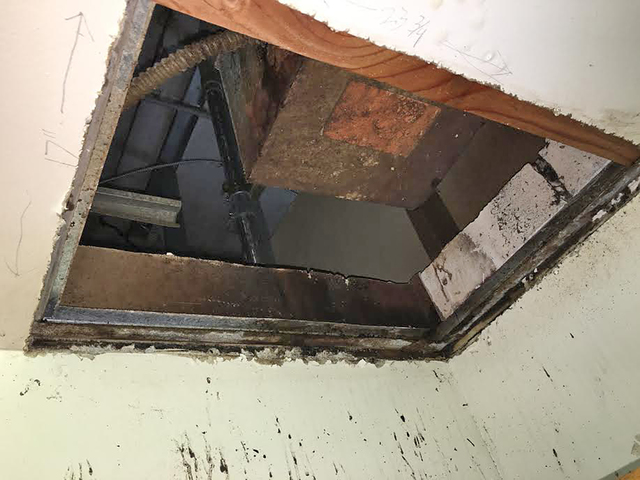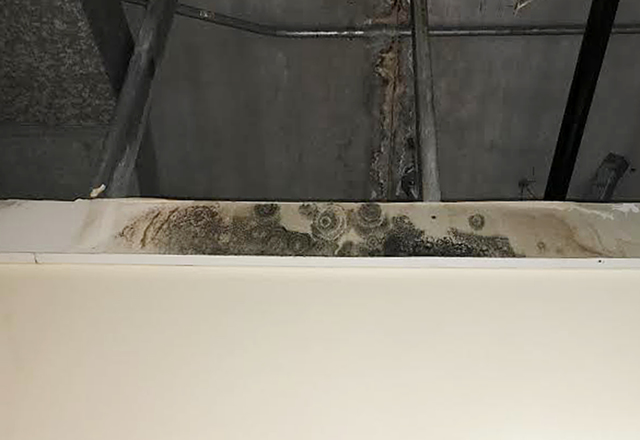HILO — Hawaii County’s wastewater treatment plant in Hilo has a mold problem.
HILO — Hawaii County’s wastewater treatment plant in Hilo has a mold problem.
An administrative building, which includes a laboratory and break room for wastewater employees, has been mostly vacated after mold was found behind the walls and ceiling.
Department of Environmental Management Director Bobby Jean Leithead Todd said a trailer was delivered last week to the plant as an alternative break room and meeting space. As a precautionary measure, respirators are being offered to workers who still need to use the building while moldy ceilings and walls are replaced. Some employees have been relocated.
The mold was discovered in the past few months as the county replaced the building’s roof, which had been leaking for years.
The leak got worse in the past three years, prompting the department to place buckets throughout the building and cover equipment with plastic, according to workers and administration officials. The building was constructed in 1990.
“You come in slippers there’s a good chance you will slide and fall on your butt,” said one wastewater worker, who spoke on the condition of anonymity. “Sometimes it would rain real hard, it stopped raining outside but it still would be raining inside.”
The county hired Compliance Solution LLC to conduct a mold study after discovering the problem.
The report, dated May 4, says mold was found on top of a bookshelf and blueprints, behind bulletin boards, in drywall and drop ceiling tiles. Water stains were found “all over the ceiling and air ducts,” the document says.
A central air conditioning system was broken and “window air conditioners appeared to be very dusty,” it says.
The document says it doesn’t consider spore levels inside the building to be “amplified” but recommends removal of drywall and ceiling material, in addition to other steps.
Four wastewater employees filed incident reports as a result of the mold out of concern it could be responsible for respiratory and other health issues.
One worker said he also filed a complaint with the Occupational Safety and Health Administration.
“We assumed it was there but we didn’t know how bad it was,” said one of the two workers who spoke to the Tribune-Herald.
“It’s almost like you have asthma now.”
Leithead Todd said the incident reports will be investigated to assess any health impacts from mold.
She said the department is working to follow through on the report’s recommendations. In the meantime, workers are having minimal, and if possible, no exposure inside.
“This is a workspace,” Leithead Todd said. “We need to go in and remediate this to address the concerns.”
There are no safety guidelines for mold exposure.
Sample traps collected in the building’s kitchen found 2,230 mold spores per cubic meter, compared to 1,190 outside. Traps in the building’s lab found 1,390 spores.
“Based on his analysis, he felt the chance of airborne mold to be very minimal to none,” said Leithead Todd, referring to the industrial hygienist who wrote the report.
But the type of mold also is causing some workers concern.
The highest mold spore concentrations were listed as penicillium/aspergillus.
The report says aspergillus and penicillium produce “toxic substances” that can create allergic reactions, headaches, vomiting and diarrhea. It doesn’t say at what exposure levels those symptoms can occur. They also were found outside in smaller concentrations.
Aspergillus and stachybotrys, which was found inside in small amounts, are both considered “black mold,” said Jeff Eckerd, indoor air quality branch manager for the state Department of Health.
The report says aspergillus wasn’t separated from penicillium because the spores are nearly identical.
Stachybotrys creates cold and flu symptoms, fatigue and general malaise, in addition to other symptoms, the report says.
Eckerd said it’s difficult to say if the mold presented a health hazard.
“You could have 100 people go into a building that has elevated mold levels,” he said. “Sometimes five might be impacted. It’s very individual specific.”
About two dozen workers use the building throughout the day, according to wastewater employees.
Many spend the bulk of their time outside or at other locations, Leithead Todd said.
She said she became aware of the leak problem in 2013 when she returned to Environmental Management after about four years leading the county Planning Department.
Dora Beck, wastewater division chief, said the building had minor leaks going back to 2008. Attempts were made to patch holes, but the problem got much worse as of 2013, when buckets had to be used to collect water.
Asked why a mold study wasn’t done before, Leithead Todd said the focus was on dealing with the leaks.
“My main concern was the fact I had buckets catching water and I was mainly concerned about people slipping and falling and getting hurt that way,” she said.
“You have to take your ceiling apart to do this.”
The roof replacement, which cost $235,000, was put into the county capital budget for the 2014 fiscal year, she said.
Leithead Todd said the county took the issue seriously, but added getting projects funded and contracts awarded is “not a process that is quick.”
It’s still not clear how much getting rid of the mold will cost or when it will be completed.
The existing contract for the mold sampling likely will be amended to add the remediation work, she said.
“We’re going to try to get it done very soon,” Leithead Todd said.


